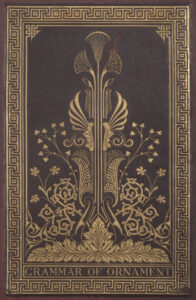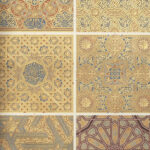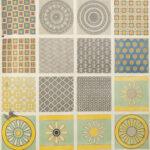Published: London, 1865
Today, we showcase a book that is important for its intellectual and artistic content, and also serves as an outstanding example of the art and technology of colored book illustration.
Owen Jones studied architecture, 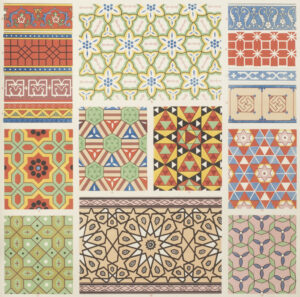 but his real interest was in architectural ornament. Early in his career he was heavily influenced by Egyptian, Turkish, and Moorish aesthetics. His designs for the interior of London’s Christ Church (1842) and, particularly, for the Crystal Palace at the Great Exhibition of 1851, attracted wide attention.
but his real interest was in architectural ornament. Early in his career he was heavily influenced by Egyptian, Turkish, and Moorish aesthetics. His designs for the interior of London’s Christ Church (1842) and, particularly, for the Crystal Palace at the Great Exhibition of 1851, attracted wide attention.
The Grammar of Ornament is Jones’ attempt to articulate specific principles of decorative beauty, with a focus on proportion, harmony, and line. His examples are drawn from nineteen cultures (Egyptian, Greek, Turkish, Renaissance,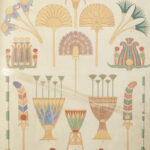 Indian, Elizabethan, and so on) as well as from nature itself. The book opens with 37 “general principles” of decorative beauty. This is followed by separate analyses of the nineteen decorative styles, each of which is accompanied by several plates of gorgeous chromolithographic illustrations.
Indian, Elizabethan, and so on) as well as from nature itself. The book opens with 37 “general principles” of decorative beauty. This is followed by separate analyses of the nineteen decorative styles, each of which is accompanied by several plates of gorgeous chromolithographic illustrations.
The title has never f allen out of favor and remains a respected, heavily-used classic. The MIT Libraries own the first edition of 1856 (originally sold by subscription), as well as later editions. In just the past dozen years, new printings and translations have appeared in English, French, and Chinese, along with a digital version of the 1856 edition. Designers, artists, and artisans continue to consult the illustrations in Grammar for patterns and for inspiration. Shelved in the Rotch Library of Architecture and Planning, MIT’s stacks copy of the 1986 London reprint is in constant circulation.
allen out of favor and remains a respected, heavily-used classic. The MIT Libraries own the first edition of 1856 (originally sold by subscription), as well as later editions. In just the past dozen years, new printings and translations have appeared in English, French, and Chinese, along with a digital version of the 1856 edition. Designers, artists, and artisans continue to consult the illustrations in Grammar for patterns and for inspiration. Shelved in the Rotch Library of Architecture and Planning, MIT’s stacks copy of the 1986 London reprint is in constant circulation.

